Philip F. Keebler and Kermit O. Phipps
EPRI Solutions, Knoxville, TN
Bradford R. Connatser
WriteNow Communication, Knoxville, TN
Introduction
What is an E3 program? Outside of the military environment, the National Aeronautical Space Administration (NASA), and the telecommunication industry, the study of electromagnetic environmental effects (E3) and spectral management (SM) are not fully understood or practiced to ensure electromagnetic compatibility (EMC) in the electromagnetic environments of nuclear power plants, industrial facilities, commercial facilities, and medical industries. In these places, EMC is essential, especially as advanced electronic devices are introduced into these environments, such as digital process controls, wireless communication devices, power electronics, electronic controls, high-tech medical equipment, computer monitors, and electronic lighting systems.
This article discusses measurement techniques found in MIL-STD-461E (Requirements for the Control of Electromagnetic Interference Characteristics of Subsystems and Equipment) [1], their intended use with different types of antennas (specified by dimension), and where and how the antennas may be applied to establish an E3 program. Also addressed is the use of IEEE 473, IEEE Recommended Practice for an Electromagnetic Site Survey (10 kHz to 10 GHz) [2], as a guide for EMC survey practices using multiple antenna types, including using the single broadband discone antenna as the preferred method for measuring emissions at sites with unknown sources of EMI. Other types of antennas that can be used to monitor an electromagnetic environment are compared to the discone antenna.
In this article, the nuclear industry is used as an example environment that would benefit from switching methods of conducting EMC surveys. The Nuclear Regulatory Commission (NRC) Regulatory Guide 1.180, Guidelines for Evaluating Electromagnetic and Radio-Frequency Interference in Safety-Related Instrumentation and Control Systems [3], instructs EMC investigators how to conduct EMC surveys in a nuclear environment. As stated in NUREG 1.180, “Selected EMI/RFI test methods from MIL-STD-461E, ‘Requirements for the Control of Electromagnetic Interference Characteristics of Subsystems and Equipment,’ and the IEC 61000 Series are endorsed to evaluate conducted and radiated EMI/RFI phenomena for safety-related I&C systems.” However, the NRC will allow an EMC investigator to choose either MIL-STD-461E or IEC 61000 but not swap between the two. Of the two, 461E covers a greater frequency range, but it is not really designed for application in site surveys only for measuring the emissions and immunity of equipment—not for measuring the environment itself. Additionally, neither MIL-STD-461E nor IEC 61000 include the discone antenna as a recommended type of antenna.
On the other hand, IEEE 473 recommends the use of the discone antenna for site surveys as well as other types, such as those listed in MIL-STD-461E and IEC 61000. The results of comparing the four types of antennas, including the discone antenna, clearly show that the discone is preferable to the other types because of its wide frequency range and its applicability to the confined spaces found in nuclear power facilities, among other types of facilities with congested areas.
However, before addressing the application of the various EMC standards and antenna selection, an overview of the E3 philosophy is provided with the goal of informing facility managers in the mentioned industries about the benefits of an E3 program.
E3 and the Spectrum-Management Philosophy
The E3 concept is a not guideline but an underlying philosophy that encompasses many well-accepted EMC disciplines to ensure effective electromagnetic compatibility between coexisting equipment and between equipment and the electromagnetic environment. Electronic devices are increasingly using the electromagnetic spectrum. Some devices are intentional sources of electromagnetic emissions, and some are unintentional sources. Regardless of the type, both are candidates for creating electromagnetic interference (EMI) problems. The only way to combat these problems is through the practice of spectrum management to prevent emissions from equipment that use or operate in the same part of the spectrum already in use by other devices.
The E3 concept helps to ensure that electronic and electrical equipment meet at least a minimum confidence level of immunity and limit unintentional emissions. Military standards such as MIL-STD-461E have been used with a high level of success to ensure electromagnetic compatibility with military and other critical systems and subsystems.
Ensuring equipment compliance with a military and/or commercial EMC standard, whether the standard describes methods of measuring equipment emissions or emissions in a facility, essentially meets only half of the requirements of an E3 program. Meeting the other half can be accomplished through monitoring and maintaining spectral content in the overall electromagnetic environment. But what does “maintaining spectral content” entail?
First, an E3 program requires that the electromagnetic environment of interest be monitored. However, an E3 program is aggressive in its approach to defining the electromagnetic environment in which critical equipment must operate. Existing efforts to monitor the spectral content of an electromagnetic environment is a worthwhile task that may not be fully realized.
In an E3 program, the parameters of a well-working electromagnetic environment must be considered, including the level of immunity believed to be required, the level of emissions measured from equipment (in a controlled laboratory environment), the level of emissions measured in a facility area (while equipment operates in an uncontrolled environment), the location of equipment, the type of equipment installation, the type of equipment, the primary functions of the equipment, the type of interface with other equipment (if any), and records of past EMI problems.
The requirements for EMC vary from equipment to equipment and environment to environment. Some industries rank these requirements based on how critical an operation is. For example, the nuclear and medical industries will usually insist on higher EMC requirements than will commercial or industrial industries. However, the spectrum at any point should be monitored when upgrades to existing controls, operations, or processes are performed or when new equipment is installed. Periodic monitoring should focus on 1) points of installed equipment, 2) areas where critical controls are located, 3) areas where reliable safety-related operations must be carried out, and 4) areas where a high concentration of processes take place. Once the environment at a point of equipment installation has been measured, the background levels of its electromagnetic environment may be easily be compared to levels in similar environments and to the susceptibility levels of the installed equipment as determined by MIL-STD-461E, its predecessor MIL-STD-461D, or another type of EMC immunity standard.
ACCEPTED SURVEY AND MEASUREMENT METHODS
The MIL-STD-461E Method
MIL-STD-461E, Department of Defense Interface Standard Requirements for the Control of Electromagnetic Interference Characteristics of Subsystems and Equipment (August 1999), is a military standard that originated during the 1940s, the prime of early military radio communication systems and platforms. It has grown into a mature standard through 60 years of trial and error in maintaining system integration and compatibility of the U.S. military’s weapons and communication platforms. During the early 1980s, it came to full maturity after the failure of attempting to run joint operations between the armed services and multiple incidents thereafter involving premature weapon launches.
Upon its issue, MIL-STD-461E superseded the family of MIL-STD-461D [4] and MIL-STD-462D [5] through consolidation of the two documents into one standard. MIL-STD-461E is comprehensive in that it includes guidance on both the equipment that generates interfering emissions and the equipment that may be susceptible to those emissions. The purpose of 461E is to establish the boundaries and related requirements for 1) verifying the control of emissions generated by electrical equipment and subsystems that may cause an EMI problem and 2) verifying that equipment is not susceptible to emissions bombarding the equipment from the environment. The standard specifies the technical requirements for controlling emissions and determining the susceptibility at the equipment and subsystem level. However, application of the standard is not suited for all types of electrical equipment and subsystems.
Some organizations rely on equipment test results obtained from applying MIL-STD-461E susceptibility limits and/or its predecessors as a means of defining the ideal electromagnetic environment where equipment will be installed. However, this standard was not developed to characterize facility environments or points of installation for equipment. Rather, its goal was to establish requirements for the control of EMI through the measurement of emissions and susceptibility characteristics of equipment. Equipment covered by the standard includes the electronic, electrical, and electromechanical equipment and subsystems designed or procured for use by the United States Department of Defense.
IEEE 473 Method
IEEE Standard 473 was developed by the IEEE EMC Society Technical Committee 3 on Electromagnetic Environments. First published in 1981, the standard takes into account that monitoring of electromagnetic environments is performed on a regular basis in the EMC community. Although the objectives, installed equipment, and site details of these monitoring efforts vary greatly, all monitoring efforts have commonalities, which IEEE Standard 473 documents. Therefore, the standard has recommended practices but allows for inevitable variances. The standardization of practices and types of monitoring equipment enables meaningful data to be collected and utilized in maintaining and controlling emissions for an E3 program.
IEEE Standard 473 was developed to address the measurement of periodic and random radiated electric and magnetic fields and conducted emissions within the frequency range of 10 kHz to 10 GHz. The guidelines in Standard 473 are specific and thorough. They provide EMC investigators with the information required to conduct onsite EMC surveys, including selecting an appropriate antenna, placing the antenna, selecting measurement equipment, placing measurement equipment and their detectors, and handling of all collected data. Following the measurement guidelines offered in this standard for characterizing electromagnetic environments, investigators can determine the values of basic site parameters—such as signal frequency, amplitude, and how often spectral components occur—by taking data samples with EMC monitoring equipment. Then, investigators can document their findings for subsequent data analysis and recommend any required actions.
With respect to the planning and scheduling of monitoring efforts, Standard 473 offers guidance on durations for monitoring:
1. EMI from periodic sources, such as emissions from the polling of fire and smoke alarm sensors, power-line carrier-based clocks, and handheld radio transceivers.
2. EMI from natural sources of random noise, such as atmospheric and solar emissions.
3. EMI from the normal operation of facility equipment, such as emissions generated by electronic power supplies, digital equipment, and arcing contacts.
To characterize a facility environment where all three of these EMI sources are expected, the standard recommends a monitoring duration of 14 days, with a 1-hour inter-sampling interval, a minimum sample length of 3 minutes, and a minimum of 11 data points (or sweeps if an analyzer is used) per sample to ensure a high statistical confidence.
Antenna Selection
IEEE Standard 473 provides detailed guidance on selecting and placing an antenna for EMC monitoring of an electromagnetic environment. Each of the seven basic antenna designs shown in Table 1 is described. These seven antenna types have been used for site surveys to measure radiated emissions.
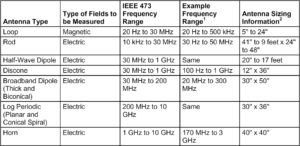
1. These antennas with these frequency ranges were selected for use in a survey.
2. Dimensions are approximate width by height.
The loop antenna is the only antenna in the list designed to measure magnetic fields. Magnetic field antennas are typically small and easy to maneuver around a site. They may be placed out in an open room for area measurements or close to the surface of an enclosure or cable assembly or tray for measuring magnetic-field emissions for point-of-installation measurements. The loop can be easily rotated for measurements in all axial directions.
Antennas designed to measure electric fields are typically larger and are more difficult to maneuver around a site, especially a site where equipment cabinets may be close together, where pipes and girders run from floor to ceiling and from wall to wall, and where large pieces of electrical machinery may be installed. As shown in Table 1, all of the electric-field antennas, with the exception of the discone, have width and height dimensions that are rather large. The discone is narrow (12 inches) and extends to about 36 inches high (without a tripod). The size of the larger electric-field antennas makes it difficult to position and rotate them in an area congested with equipment and building systems and structures. Moreover, to cover a frequency range from 30 Hz to several gigahertz would require at least three antennas if the discone is excluded from the list, as it is in MIL-STD-461E and IEC 61000. However, with the discone antenna, electric-fields may be measured across a wide band (100 Hz to 1 GHz).
Simply put, the larger the antenna, the more difficult it is to use them in an environment where obstacles can interfere with antenna placement and where larger antennas cannot be rotated to identify maximum signal strength. In many environments, support structures cannot be moved to accommodate a large antenna, and compacted clearances interfere with setting up a large antenna. The inability to maneuver an antenna can limit the data-taking process and reduce the amount of meaningful collected data. Because of its small size and wide frequency band, the discone antenna is ideal when conducting EMC monitoring in confined spaces.
Moreover, IEEE Standard 473 recommends that discone antennas be used when the location of a radiating source is unknown, as is often the case when conducting a site survey. Even if several types of equipment or machinery are suspected of contributing to a potential EMI problem, the primary purpose of conducting a site survey in an open area or at a potential point of installation for a new device is not to find a source of emissions but to determine amplitudes and frequencies of radiated emissions in the background that could lead to an EMI problem with that device. Thus, one can see that the most versatile and useful type of antenna is the discone antenna.
The Discone Antenna
To allow measurements to be taken in confined spaces and to minimize the number of antennas required, the discone antenna should be selected to be as broadband as possible. Discone antennas are available from about 100 Hz to several gigahertz. As shown in Figure 1, there are two basic types of discone antennas. The term discone appropriately describes the form of the antenna. Broken down, the term stands for the disc at the top of the antenna and the cone arrangement of the antenna element (or elements). The discone antenna on the left consists of radial rods arranged in a cone form. Some discone antennas have solid cones made of copper, as shown in the right figure.
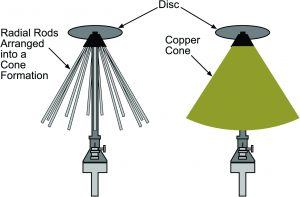
Figure 2 shows a discone antenna placed in a confined space. In the case reported in this article, the cone of the antenna was composed of 16 radial rods. The slope of the cone elements away from the disc enables the broad frequency range of the antenna. This broad frequency range provides for a smooth transition between multiple wavelengths with minimal discontinuities between bands. It also provides for an omni-directional detection pattern, meaning that it will detect signals originating from any direction and does not have to be rotated to find the maximum signal strength. These antennas are available in active and passive designs. Because some noise (emission) components may need amplifying, active designs are more suited for site surveys. They are available with the battery-power option if a 120-volt source is not within the site area or if the AC power cord needs to be eliminated for convenience.

Critical Electromagnetic Environments
Non-nuclear environments such as industrial, commercial, and medical environments have experienced a multitude of EMI problems—some caused by traditional sources of EMI and others by newer sources of EMI. Experiencing these problems has forced end users in these environments to recognize new types of emissions, potential (and identified) sources of interference, and new types of EMC solutions. The identification of new sources and the influx of new digital systems mixed with some analog systems in these environments have caused an increased level of awareness of EMI problems, including a new need to monitor their electromagnetic environments when significant changes to equipment are made. Some background on a few of the EMI experiences in these environments will help illustrate how some aspects of these environments are similar to the electromagnetic environments in nuclear power plants.
How do EMI problems in industrial, commercial, and medical environments correlate to potential problems in the nuclear industry? As technologies change, they are first introduced in the private sector, where the occurrence of an EMI problem is less likely to cause shutdown of critical equipment. In the medical industry, medical devices are now subjected to more extensive EMC immunity testing, devices incorporate wide use of filters and shields to limit internal emissions and increase immunity to external emissions, and the industry has conducted some site surveys to learn something about their electromagnetic environments. This approach has not yet been applied to industrial equipment slated for use in a nuclear plant at a level that will further limit internal emissions and harden equipment to external emissions. A simplified process for monitoring EMI in industrial, commercial, and medical environments can also be applied to help determine the characteristics of environments in nuclear power plants facing digital upgrades. This approach will identify what precautions are required to prevent EMI problems in these plants.
Industrial Environments
First, let’s consider an industrial environment, which tends to use many computer-controlled devices to improve efficiency and accuracy. The financial impacts of EMI problems in such an environment may not be fully realized. In industrial environments, the shutdown of a programmable logic controller (PLC) may interrupt an entire production line. Financial losses are multiplied by the hour when a company is unable to produce, package, and ship its products.
Industrial facilities are increasingly using power electronic and digital devices such as PLCs and adjustable-speed drives (ASDs). PLCs use intelligent algorithms to control remotely located processes through a maze of communication cables to improve process efficiency and accuracy and more closely monitor critical process conditions. Some industrial systems also use wireless control schemes. ASDs use pulse-width modulation algorithms tied to fast power electronic switching devices for better control of motors for increased production (better motor control) and improved energy efficiency. The combination of PLCs and ASDs and the intermixing of the controls and power feeds have produced some unpredictable results and unexpected shutdowns. Other types of EMI problems, such as the confusion of sensors, have occurred from the emissions generated by switch-mode power supplies.
Commercial Environments
The increased use of power electronic and digital devices has also caused a plethora of EMI problems in the electromagnetic environments of commercial facilities. There have been numerous cases where ASDs were installed as part of an overall energy-management program for HVAC systems in large facilities. Some of these installations have resulted in the malfunction of radio-frequency-based theft-detection devices, premature failure of electronic lighting due ASD-controlled elevators, and malfunction of power-line-carrier-operated energy-management systems that conflict with electronic lighting ballasts. Electronic lighting systems have also been known to cause EMI problems with energy-management systems, power-line-carrier-based clock systems, and fire-alarm systems, to name only a few. In the extreme, high-level emissions generated by radio-communication devices and failing electronic equipment have been identified as causing severe upsets with desktop computers.
EMI problems in commercial environments can be costly, just as they are in industrial environments. The failure of a theft-detection system to detect for unpaid merchandise, for example, can cause lost revenue for retail stores, with the manufacturer of the theft-detection system getting the blame for lost goods. If theft-detection systems are rendered inoperable in high-tech electromagnetic environments, then manufacturers of theft-detection systems stand to lose future sales of their systems, retail stores stand to lose merchandise to theft, and the magnetic strips embedded in product packages are fruitlessly manufactured and attached to products.
Medical Environments
Healthcare environments utilize hundreds of advanced electronic medical equipment employing power electronic and digital devices, even combined with analog devices in many cases. In some cases, a medical device will use a specific type of interface or subsystem to administer a treatment to a patient. Some of these interfaces or subsystems purposely generate radio-frequency emissions as a part of the therapy. Others generate emissions as a byproduct of a therapy. A medical environment poses even more serious consequences of EMI than industrial and commercial environments. In a typical medical environment, EMI can interfere with medical procedures that involve sensitive computer-controlled devices. The cost of repeated patient processes adds to the bottom-line losses of hospitals and other healthcare organizations.
While these losses are important, they hold no ground to the potential for injuries to patients, not to mention the court costs and out-of-court settlements associated with EMI problems that result in patient injury or even death. The identification of numerous EMI problems with medical equipment has resulted in the filing of multiple lawsuits having for equipment malfunction, with some cases involving wrongful death, misdiagnoses, and unnecessary surgical operations. Some problems were based on EMI artifacts discovered in simple electrocardiogram readings, scans from diagnostic medical images, and unrecognizable measurements and responses from many other advanced electronic medical systems whose sensitivity levels are at best defined as “extreme,” where the signal amplitudes in a medical-device transducers compete with those in a typical electromagnetic environment. In addition, systems that prevent nursing-home patient from wandering out of a facility and infants from being stolen from nurseries have been rendered inoperable due to emissions from failing hardware on utility power-distribution systems, fire alarm controls, solid-state light dimmers, and emissions from computer monitors.
Comparing Broadband Antennas
As stated previously, many government programs cite MIL-STD-461E and/or its predecessors as a means of measuring the environment in which the equipment will be installed, and why not? MIL-STD-461E prescribes the use of at least four basic antenna types to determine emission levels and susceptibility threats of equipment and systems. In some environments, the use of 461E methods can be used without difficulty.
Here, we compare the use of three antennas as prescribed by MIL-STD-461E and the use of a discone antenna as recommended by IEEE 473 to measure radiated emission in a nuclear power plant—an environment with congested spaces. All measurements were taken at a potential point of installation of a digital control system in the nuclear power plant. The purpose of the comparison was to determine the effectiveness of the four antenna types in accurately measuring EMI and the ease of use. Measurements for all four antennas were compared in the frequency range between 10 kHz and 1 GHz. For measuring electric fields, three antennas as prescribed by MIL-STD-461E were used to cover the range of 10 kHz to 1 GHz. These were the 41-inch rod antenna with a frequency range of 10 kHz to 30 MHz, a biconical antenna with a frequency range of 30 MHz to 200 MHz, and a rather large and cumbersome double-ridge horn antenna with a frequency range of 170 MHz to 3 GHz. The small, easy-to-maneuver discone antenna used for the same measurements had a frequency range of 10 kHz to 1 GHz.
Figure 3 illustrates the use of a double-ridge horn antenna used for measuring radiated emissions from 170 MHz to 3 GHz, but the frequency range of interest in this survey was 200 MHz to 1 GHz. It is rather apparent from Figure 3 that the horn antenna is not the ideal antenna for measuring emissions in a confined environment or for making measurements near a potential point of installation for new equipment. Areas like this are just too compact and cluttered with metal objects.
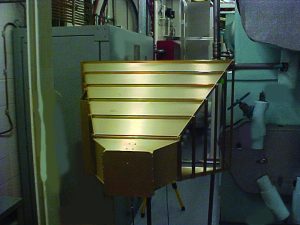
Figure 4 shows a biconical antenna placed on a wooden EMC tripod to accomplish the same objective as the horn antenna. Even when using the biconical antenna, the antenna placement was cumbersome, and the required rotation was not possible in the confined space at this site.
Biconical and ridge horn antennas are directional measurement devices. Therefore, they are required to be placed in specific horizontal and vertical position (a specific azimuth) during the measurement process. This requirement increases the number of sweeps that must be performed with an analyzer and complicates measurement procedures for automated measurement systems where the investigator may not be present to rotate an antenna. In fact, IEEE Standard 473 discourages the use of horn antennas in environmental surveys, stating, “The commercially available directional antennas, such as log-spirals and horns should not be used for man-made noise surveys unless the source locations have been well defined and the directional azimuthal pattern of the antenna can be accurately oriented towards them.” In this particular application at a nuclear plant, the antenna was used as a mandated 461E requirement.
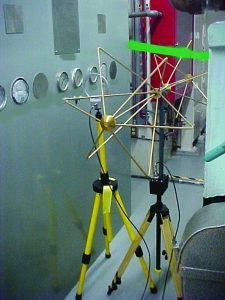
In addition to support structures and compacted clearances interfering with the typical MIL-STD-461E antenna setups, another problem associated with the antenna setup is the amount of time spent onsite setting up for three antennas and conducting repeated measurements. This requires many hours of pre-site planning, staff coordination at the site, and then conducting numerous measurement sets. Often, the amount of time that plant staff must spend escorting and assisting EMC engineers is difficult for the customer to provide with limited man hours.
Aside from this, the nature of the radiated emissions in a power plant environment is such that most sources of emissions—from power supplies, motors, high-intensity discharge lamps, and so on—are random in nature. Adhering to the recommended practice of IEEE 473, “Site conditions dominated by random noise sources require much longer observation intervals. . . . A minimum test duration of two weeks ensures repeatable diurnal measurements.” Having to utilize only one antenna (a broadband discone) with no reorientation requirements would minimize the amount of required measurement time. Broadband discone antennas are ideal for use with automated measurement systems, with one objective of such systems being to minimize the interaction between the EMC engineer and the measurement equipment. With the use of multiple antennas and directional requirements, the recommended assessment time could extend into several weeks or months. More reasonable and manageable assessment times can be realized with automated systems that capture more sweeps and use only one antenna—the discone.
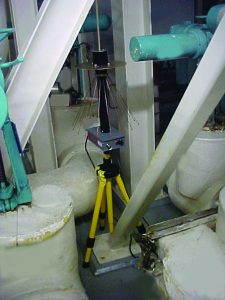
The use of a single extremely broadband discone antenna alleviates these measurement problems. The discone antenna shown in Figure 5 covers the entire electric field spectrum from 10 kHz to 1 GHz. Once it is located at the point of interest, whether in the middle of a large floor area or close to a potential point of installation for future or existing equipment, it does not need to be moved, raised, lowered, or rotated. Discones are omni-directional in design, eliminate the need for two sets of measurements, and are available in wide spectrum range. The discone antenna has a low profile and is easy to set up in tight quarters. In the setup shown in Figure 5, the discone antenna is surrounded by seismic steel members and equipment. The discone antenna is the preferred surveillance antenna of use for broad spectrum sweeps and is advocated in IEEE 473, which states that “the antenna for noise measurements should be vertically polarized and have an omnidirectional azimuthal pattern.” In addition, IEEE 473 states that “above 100 MHz, and into the superhigh frequency (shf) band, a discone, a monopole, or a half-wave dipole antenna cut for each frequency is preferred.” Thus, discone antennas seem to be the most practical antenna of choice for measuring background noise in congested and cluttered electromagnetic environments.
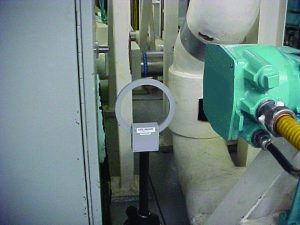
Part of an E3 program requires measurement of magnetic fields. For comparison, magnetic fields are typically easier to measure because the antennas are much smaller. When measuring magnetic fields, standard magnetic-field-sensing loop antennas may be used where magnetic fields in the X, Y, and Z axes are to be measured. Figure 6 shows a loop antenna positioned where the strongest fields are detected if multi-axis measurements are not required. However, if multi-axis measurements are required, a better method would be to use a combined-axis loop antenna for the assessment so that rotation of the loop is not required to sense fields in all three directions. One advantage of these antennas is their small size, making them easy to place in compact and congested areas.
Comparison Results
Comparing the spectral information taken with the antennas recommended by MIL-STD-461E to the spectral information taken with the broadband discone antenna recommended by IEEE 473 yielded some interesting results. Figure 7 shows the results of the environment survey at a potential point of equipment installation, contrasting the radiated-emissions data measured with the discone antenna with the data measured with the three antennas prescribed by MIL-STD-461E. All of the results are comparable in demonstrating that the existing environment did not exceed the radiated susceptibility limit of the equipment to be installed in a nuclear power plant according to NRC Regulatory Guide 1.180, Guidelines for Evaluating Electromagnetic and Radio-Frequency Interference in Safety-Related Instrumentation and Control Systems. The differences between the two traces in the figure are attributable to antenna placement, interaction between the antennas and surrounding metal objects, and antenna design (the discone is omni-directional, while the others are polarized).

Conclusions
What was accomplished with three polarized antennas, the omni-directional discone antenna was able to accomplish over the same frequency range. When comparing the discone antenna to the antennas required to carry out an EMI survey according to MIL-STD-461E, the discone is easier to set up, takes up less space, and requires a shorter monitoring period to obtain the required data. However, one should note most importantly that antenna selection is only a small part of an E3 program.
In managing their electromagnetic environment, all industries would greatly benefit from adopting an E3 and spectral-management program. However, the risks associated with not quantifying an electromagnetic environment are too high, as are the risks associated with allowing excessive facility emissions to impinge upon equipment in critical industries such as medical and nuclear. The benefits and advantages of such a program for critical industries are many, but primarily it would enable plant managers to document and track activities associated with controlling their electromagnetic environments.
Engineers in the nuclear industry who are responsible for equipment modifications (such as digital upgrades) have been focusing on typical issues such as interconnects, installations, and comparing the performance of digital equipment to the well-accepted analog equipment. Some attention has been given to characterizing digital equipment, including their EMI emissions and immunity, but little attention has been given to characterizing the EMI at points of installation to determine whether high levels of emissions that could shut down digital equipment are present. Moreover, just as hospitals discovered, the installation of digital equipment completely reshapes an electromagnetic environment, which can result in new types of EMI problems. This discovery will hold true for the nuclear industry as well, especially as more digital devices are installed. Thus the need for site surveys continues to increase in nuclear facilities as the existing inventory of analog equipment must continue to operate with new digital equipment.
Because the nuclear industry will be conducting hundreds of digital upgrades to instrumentation and control equipment in their plants, nuclear facilities should not tarry in establishing E3 programs to ensure that radiated emissions do not exceed limits adopted by the NRC. The application of automated computer-based emission-measurement systems, including the use of the discone antenna, will make the process of capturing data more efficient. Maintaining engineering efficiency while ensuring that the emissions at the point of installation are low will help to ensure that plant environments are qualified for digital upgrades.
References
1. MIL-STD-461E, Department of Defense Interface Standard Requirements for the Control of Electromagnetic Interference Characteristics of Subsystems and Equipment, U.S. Department of Defense, August 1999.
2. IEEE Standard 473-1985, IEEE Recommended Practice for an Electromagnetic Site Survey (10 kHz to 10 GHz), Institute of Electrical and Electronics Engineers, 1991.
3. NUREG 1.180, Guidelines for Evaluating Electromagnetic and Radio-Frequency Interference in Safety-Related Instrumentation and Control Systems, U. S. Nuclear Regulatory Commission, 1996.
4. MIL-STD-462D, Measurement of Electromagnetic Interference Characteristics, U.S. Department of Defense, 1993.
5. MIL-STD-461D, Requirements for the Control of Electromagnetic Interference Emissions and Susceptibility, U.S. Department of Defense, 1993.
For Further Reading
Guidelines for Electromagnetic Interference Testing in Power Plants, Revision 3 to EPRI TR-102323, TR-1003697, Electric Power Research Institute, Palo Alto, CA, 2004.
________________________________________
Kermit O. Phipps is a NARTE Certified EMC engineer and conducts tests and evaluations of equipment performance in accordance with standards of ANSI/IEEE, IEC, U.S. Military, and UL, as well as with the EPRI System Compatibility Test Protocols for EPRI Solutions. He served in the U.S. Air Force as a manual electronic warfare and component specialist, resolving hardware and software problems. He conducts research on surge protection, power-line filters, shielding effectiveness, and electromagnetic interference. Mr. Phipps is the author and co-author of test plans, protocols, and research papers presented at international power quality and EMC conferences. He has conducted a number of power quality and EMC training sessions and field investigations. Most recently, he has completed his voluntary work on developing a new EMC standard for power-line filters, IEEE 1560 where he served as Chairman.
Philip F. Keebler has conducted System Compatibility Research on personal computers, lighting, medical equipment, and Internet data center equipment. The lighting tasks were associated with characterizing electronic fluorescent and magnetic HID ballasts, electronic fluorescent and HID ballast interference, electronic fluorescent and HID ballasts failures, electronic fluorescent and HID lamp failures. He has drafted test protocols and performance criteria for SCRP tasks relating to PQ and EMC. Mr. Keebler also manages the Electromagnetic Compatibility (EMC) Group at EPRI Solutions where EMS site surveys are conducted, end-use devices are tested for EMC, EMC audits are conducted, and solutions to electromagnetic interference (EMI) problems are identified. He has completed his voluntary work on developing a new EMC standard for power-line filters, IEEE 1560 where he served as Editor.
Bradford R. Connatser owns and operates WriteNow Communication, a technical communication firm located in Knoxville, Tennessee. He has published dozens of articles on communication and electrical engineering. He is a senior member of the Society for Technical Communication, a member of the IEEE, and a member of the IEEE Professional Communication Society. He earned his master’s degree in English from Temple University and spent three years teaching English at the college level before pursuing a career in professional writing and editing for an engineering company. His research includes applying cognitive psychology to technical communication, a field in which he has published dozens of award-winning articles.
